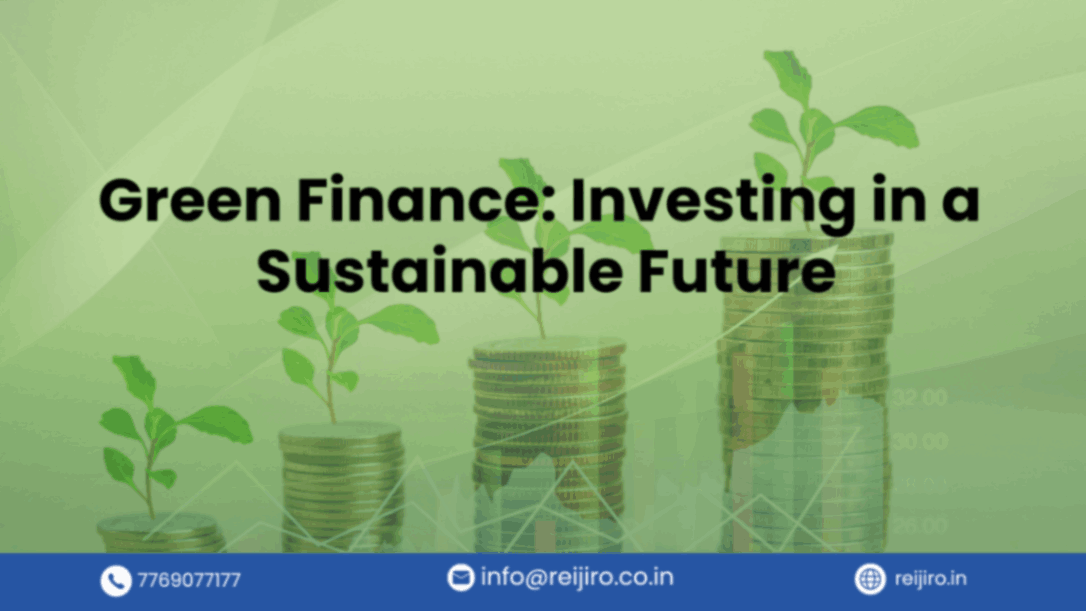Green Finance: Investing in a Sustainable Future
In an era marked by increasing environmental awareness and the urgent need to address climate change, the concept of “green finance” has emerged as a powerful tool for shaping a sustainable future. Green finance goes beyond traditional investment practices, emphasizing the allocation of funds toward environmentally friendly projects and initiatives that contribute to a greener, more resilient global economy. In this comprehensive blog, we will delve into the intricacies of green finance, exploring its significance, key components, benefits, challenges, and its role in accelerating the transition to a sustainable and low-carbon world.
Understanding Green Finance
Green finance, also referred to as sustainable finance or environmentally responsible finance, involves the integration of environmental, social, and governance (ESG) criteria into financial decision-making processes. Its primary aim is to channel capital toward projects and activities that promote sustainability, protect the environment, and drive positive social impacts.
The overarching goal of green finance is twofold: to support the transition to a low-carbon and resource-efficient economy while simultaneously safeguarding natural resources and ecosystems. This is achieved by encouraging investments in renewable energy, energy efficiency, sustainable infrastructure, conservation, clean technology, and other initiatives that align with environmental goals.
Components of Green Finance
Green finance encompasses a variety of components that work together to promote sustainability, environmental responsibility, and long-term economic viability. These components offer a comprehensive framework for channelling capital into projects and initiatives that contribute to a greener future. Let’s explore the key components of green finance:
Green Bonds:
Green bonds are debt instruments issued by governments, municipalities, or corporations to raise funds for environmentally beneficial projects. The proceeds from these bonds are exclusively earmarked for projects such as renewable energy infrastructure, energy efficiency improvements, sustainable transportation systems, and more. Green bonds play a vital role in financing projects that align with environmental goals.
Sustainable Investment Funds:
Sustainable investment funds, also known as green funds or ethical funds, are investment vehicles that allocate capital to companies and projects with positive environmental and social impacts. These funds consider both financial returns and sustainability criteria when selecting investments. They cater to investors seeking to align their portfolios with their values while contributing to a more sustainable future.
ESG Integration:
Environmental, Social, and Governance (ESG) integration involves incorporating ESG factors into investment analysis and decision-making processes. Companies are evaluated based on their performance in areas such as carbon emissions, employee welfare, diversity, board governance, and more. ESG integration enables investors to make informed decisions that align with sustainability goals.
Impact Investing:
Impact investing focuses on generating measurable positive social and environmental impacts alongside financial returns. Investors actively seek opportunities that drive positive change, such as clean energy projects, affordable housing initiatives, sustainable agriculture, and community development. Impact investing emphasizes accountability and outcomes.
Green Mortgages:
Green mortgages offer financial incentives to individuals purchasing energy-efficient homes. These incentives can include lower interest rates, reduced fees, or better terms for properties that meet specific environmental criteria. Green mortgages encourage homeowners to invest in energy-efficient upgrades and eco-friendly features.
Carbon Pricing and Trading:
Carbon pricing assigns a financial cost to carbon emissions, incentivizing companies to reduce their carbon footprint. Carbon trading involves the buying and selling of emission allowances. Companies that exceed their emissions cap can purchase additional allowances from companies with excess allowances. Carbon pricing and trading encourage emissions reduction and cleaner practices.
Green Insurance:
Green insurance promotes environmentally responsible behavior by offering incentives to policyholders who adopt sustainable practices. For instance, insurers may offer reduced premiums to companies that implement effective environmental risk management strategies. Green insurance contributes to risk reduction and sustainability efforts.
Sustainability-Linked Loans:
Sustainability-linked loans are structured to incentivize borrowers to achieve predefined sustainability performance targets. If the borrower meets these targets, they may receive reduced interest rates or other favorable terms. These loans encourage companies to integrate sustainability into their operations.
Renewable Energy Certificates (RECs):
RECs represent the environmental attributes of renewable energy generation. They are traded in renewable energy markets and allow businesses and individuals to support renewable energy without physically purchasing the energy itself. RECs help promote renewable energy adoption and investment.
Green Real Estate Investment Trusts (REITs):
Green REITs focus on environmentally responsible real estate investments. They can involve properties that meet high energy efficiency standards, have sustainable building features, or contribute to urban renewal and revitalization.
Eco-Friendly Project Financing:
Banks and financial institutions offer specialized financing for projects that align with sustainability goals. These projects can include renewable energy installations, energy-efficient building construction, sustainable agriculture, and more.
Certification and Verification Systems:
Certification and verification systems, such as LEED (Leadership in Energy and Environmental Design) for buildings, provide standards for evaluating and certifying the sustainability of projects. These systems provide a framework for assessing the environmental impact of developments.
The Role of Financial Institutions
Financial institutions play a crucial role in driving the components of green finance. They serve as intermediaries between investors seeking sustainable opportunities and projects in need of funding. Financial institutions also contribute by:
Issuing Green Bonds: Banks and corporations issue green bonds to raise capital for environmentally beneficial projects.
Offering Green Loans: Financial institutions provide loans with favorable terms to fund green initiatives such as renewable energy projects and energy-efficient upgrades.
Facilitating Impact Investments: Financial institutions manage sustainable investment funds and impact investment vehicles, connecting investors with projects that align with their values.
ESG Analysis: Financial institutions conduct ESG analysis to assess the sustainability performance of companies and inform investment decisions.
Promoting Sustainability Reporting: Financial institutions encourage companies to disclose their ESG practices, enabling investors to make informed choices.
The Benefits of Green Finance
Green finance offers a multitude of benefits that extend beyond traditional financial gains, encompassing environmental, social, and economic advantages. As the world grapples with pressing issues such as climate change and resource depletion, the adoption of green finance practices becomes increasingly critical. Here are some of the notable benefits of green finance:
1. Environmental Impact:
a. Carbon Emission Reduction:
Green finance channels investments into renewable energy, energy efficiency, and clean technologies. These initiatives directly contribute to reducing carbon emissions, combating climate change, and mitigating the adverse effects of global warming.
b. Biodiversity Preservation:
Funding for conservation projects and sustainable land use practices helps protect ecosystems, safeguard biodiversity, and maintain ecological balance.
c. Natural Resource Conservation:
Green finance supports projects focused on efficient resource management, waste reduction, and responsible consumption, ensuring the sustainable use of natural resources.
2. Financial Resilience:
a. Risk Mitigation:
Companies that adopt sustainable practices and demonstrate good environmental management are better positioned to mitigate risks associated with environmental regulations, resource scarcity, and reputational damage.
b. Long-Term Viability:
Investing in green projects can lead to improved long-term financial performance as businesses adapt to changing market demands and evolving consumer preferences for sustainable products and services.
c. Enhanced Asset Value:
Sustainable buildings and infrastructure are often more resilient to extreme weather events and have lower operating costs, resulting in increased property values and reduced maintenance expenses.
3. Technological Innovation:
a. Clean Technology Development:
Green finance incentivizes research and development in clean technologies, spurring innovation and creating economic opportunities in sectors such as renewable energy, electric transportation, and waste management.
b. Competitive Advantage:
Companies at the forefront of adopting green technologies and sustainable practices gain a competitive edge by offering innovative solutions and attracting environmentally conscious consumers.
4. Improved Brand Reputation:
a. Social Responsibility:
Embracing green finance initiatives demonstrates a commitment to social responsibility, boosting a company’s reputation and credibility among customers, investors, and stakeholders.
b. Stakeholder Engagement:
Businesses that prioritize sustainability attract and engage a diverse range of stakeholders who are increasingly concerned about environmental and social issues.
5. Social Benefits:
a. Job Creation:
Green finance projects, such as renewable energy installations and sustainable infrastructure development, generate employment opportunities in local communities.
b. Health and Well-Being:
Investments in clean air, water, and sanitation projects contribute to improved public health and overall well-being, leading to healthier communities.
c. Inclusive Growth:
Green finance can be directed toward projects that benefit underserved and marginalized communities, ensuring that the benefits of sustainable development are widely distributed.
6. Regulatory Compliance:
a. Anticipating Regulation:
Embracing green finance positions companies to comply with emerging environmental regulations and stay ahead of legal requirements, reducing the risk of penalties and litigation.
b. Policy Alignment:
Businesses that align their strategies with sustainability goals are more likely to receive support from governments and policymakers, creating a conducive environment for growth.
7. Economic Growth and Resilience:
a. New Markets and Industries:
Green finance opens opportunities for new markets and industries focused on sustainability, stimulating economic growth and diversification.
b. Resilience to Shocks:
A sustainable economy, supported by green finance practices, is better equipped to withstand economic shocks and global disruptions, ensuring long-term prosperity.
8. Fostering Innovation:
a. Collaboration and Knowledge Sharing:
Green finance encourages collaboration among industries, academia, and governments to develop innovative solutions for environmental challenges.
b. Research and Development:
Investments in sustainable technologies drive research and development, leading to breakthroughs that address pressing environmental issues.
Challenges and Considerations
While green finance offers immense promise, it also faces several challenges that need to be addressed:
1. Measurement and Reporting:
Assessing the environmental impact of projects and ensuring transparency in reporting remains a challenge. Standardized metrics and reporting frameworks are essential to accurately evaluate the effectiveness of green finance initiatives.
2. Risk Assessment:
Evaluating the risks associated with green investments, such as regulatory changes or technological uncertainties, requires specialized knowledge and expertise.
3. Market Volatility:
The relatively new and evolving nature of green finance can lead to market volatility and uncertainty, making it important for investors to carefully assess risks and opportunities.
4. Financing Scale:
Green finance must scale up to meet the global challenges of climate change and resource depletion. Mobilizing the necessary capital requires collaboration among governments, financial institutions, and the private sector.
5. Inclusive Impact:
Ensuring that green finance benefits all segments of society, including underserved communities, is crucial for achieving equitable and sustainable outcomes.
The Role of Governments and Policies
Governments play a pivotal role in shaping the trajectory of green finance through policies and regulations. Some key measures include:
Green Incentives: Governments can provide incentives such as tax breaks, grants, and subsidies to encourage private investments in green projects.
Green Bonds Issuance: Governments can issue green bonds to finance environmentally friendly infrastructure and projects, setting an example for the private sector.
Regulation and Reporting: Implementing regulatory frameworks that require companies to disclose their ESG practices and performance can foster transparency and accountability.
Carbon Pricing: Governments can establish carbon pricing mechanisms to internalize the costs of carbon emissions and encourage industries to adopt cleaner practices.
Conclusion
Green finance has emerged as a critical driver of sustainable development, enabling the efficient allocation of capital toward projects that combat climate change, enhance environmental protection, and promote social well-being. By integrating ESG considerations into financial decisions and investing in green initiatives, individuals, businesses, and institutions have the power to accelerate the transition to a more sustainable future. As stakeholders across the globe recognize the urgency of addressing environmental challenges, green finance stands as a powerful mechanism for aligning financial interests with the broader goal of safeguarding our planet for generations to come.
In conclusion, green finance represents a powerful and innovative approach to addressing the urgent challenges of environmental sustainability, climate change, and resource depletion. It goes beyond traditional financial practices, integrating environmental, social, and governance considerations into investment decisions and financial strategies. As we navigate the complexities of a rapidly changing world, green finance emerges as a beacon of hope and a roadmap towards a more sustainable future.
Through various components such as green bonds, sustainable investment funds, ESG integration, and impact investing, green finance paves the way for a shift towards a low-carbon and resource-efficient global economy. The benefits it offers are extensive and far-reaching, touching upon environmental protection, financial resilience, technological innovation, brand reputation, social well-being, and more. By embracing green finance, individuals, businesses, and governments alike can collectively contribute to positive environmental change while reaping the rewards of economic growth and long-term viability.
However, the journey towards a sustainable future through green finance is not without its challenges. Issues such as measurement and reporting, risk assessment, market volatility, and the need for inclusive impact must be effectively addressed. The success of green finance hinges on collaboration, education, policy alignment, and a steadfast commitment from all stakeholders.
As we navigate these challenges and seize the opportunities presented by green finance, we embark on a path that holds the promise of a world where economic prosperity and environmental stewardship are harmoniously intertwined. By integrating sustainability principles into our financial decisions, we can ensure that the choices we make today resonate positively for generations to come.
Ultimately, green finance is more than a financial strategy; it is a philosophy that reflects our shared responsibility for the planet and its inhabitants. It is a commitment to leave a legacy of resilience, abundance, and harmony. By embracing green finance and investing in a sustainable future, we embrace the potential to create a world that thrives in balance with nature, where progress is aligned with the well-being of our planet and its inhabitants.



